Welcome back! By now, you should know the drill—Living Ink is a weekly series that outlines a featured character’s powers, personality, and comic book history, and then discusses how all of that flavor has been translated for and incorporated into Vs. System cards.
In the previous two articles, I focused on more traditional super hero and super villain fare with Spider-Man and Dr. Octopus. This week, though, we’re going to take a walk on the mystical side and look at the Sorcerer Supreme himself, Dr. Strange.
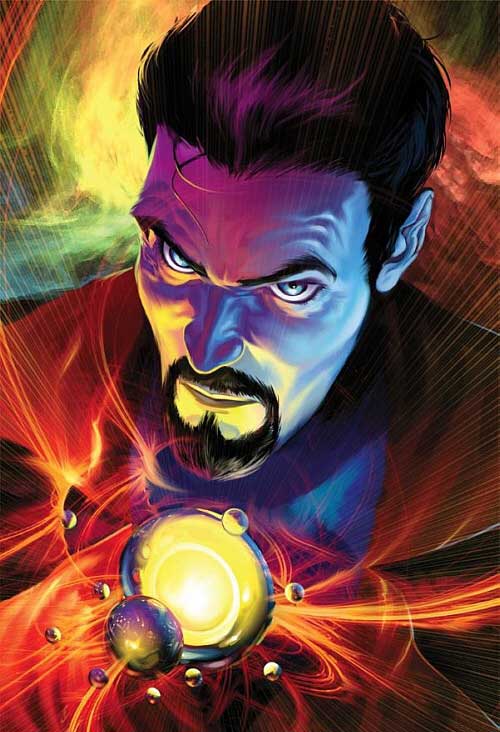
Like many of the greatest Marvel characters that still command the imagination of hundreds of thousands of fanboys and girls worldwide, Dr. Strange was created by Stan Lee (in partnership with artist Steve Ditko, who was also Lee’s co-creator on Spider-Man). His first appearance was in Strange Tales #110, published in July 1963. Initially, Dr. Strange’s adventures shared this title 50-50 with those of other characters (most notably the Human Torch and Nick Fury), but this changed in June 1968 with issue #169, when he took center stage and the series was renamed Doctor Strange.
Dr. Strange is the Sorcerer Supreme of the Marvel universe, and as the title suggests, he is one powerful dude. Ultimately, the buck pretty much stops with him when it comes to defending our world from a myriad of mystic threats including devils, demons, ghouls, and human villains who choose to pursue the dark arts. In addition to being an unrivalled master of the mystic arts, Dr. Strange often acts as an adviser to other heroes when they encounter arcane or supernatural threats.
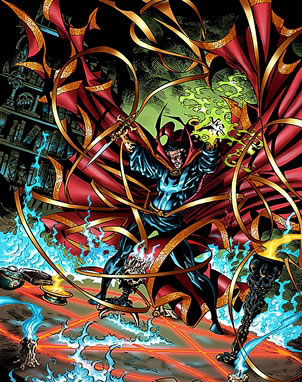 Being a master magic user, Dr. Strange’s powers seem to be limited only by the imagination of whoever is crafting the comics in which he appears. Theoretically, there is literally nothing Dr. Strange can’t do given a bit of prep time to consult the appropriate enchanted texts. Most of his powers are purely mystical in nature, and include abilities such as energy bolts, force fields, teleportation, transmutation, telepathy, telekinesis, scrying, Astral Projection, and practically any magical spell you or anybody else can think of. Dr. Strange’s access to these powers is granted by his own personal mystic training, by drawing upon the ambient energy of the universe, or by channeling energy from countless nigh-omnipotent mystical and non-mystical beings in countless dimensions.
Being a master magic user, Dr. Strange’s powers seem to be limited only by the imagination of whoever is crafting the comics in which he appears. Theoretically, there is literally nothing Dr. Strange can’t do given a bit of prep time to consult the appropriate enchanted texts. Most of his powers are purely mystical in nature, and include abilities such as energy bolts, force fields, teleportation, transmutation, telepathy, telekinesis, scrying, Astral Projection, and practically any magical spell you or anybody else can think of. Dr. Strange’s access to these powers is granted by his own personal mystic training, by drawing upon the ambient energy of the universe, or by channeling energy from countless nigh-omnipotent mystical and non-mystical beings in countless dimensions.
Dr. Strange’s own power is often amplified by numerous magical artifacts. The two artifacts he carries with him at all times are the Eye of Agamotto and the Cloak of Levitation. The Eye of Agamotto allows Dr. Strange to see through any lie, deception, or illusion, and free others that are trapped in their own illusions. It is often used to amplify his mind’s eye, giving him psychic abilities that rival the most powerful of telepaths, but it can also be used to play back an area’s past events and open dimensional portals. The Eye can also be used as a weapon, but most beings cannot withstand its light; due to its often-lethal effect, Dr. Strange usually only employs it offensively as a last resort. Meanwhile, the Cloak of Levitation allows him to fly and can even be used like another limb to attack a foe. It is also nearly indestructible. Other notable artifacts include the Orb of Agamotto, the Wand of Watoomb, and the Book of the Vishanti.
Dr. Strange is even an accomplished martial artist . . . is there anything this guy can’t do?
In terms of personal history, Dr. Stephen Strange was once an accomplished but arrogant surgeon. This brilliant career and the personal fortune it provided him were dealt a fatal blow after an automobile accident that left him with subtle yet profound neurological damage. His prized hands could no longer be relied on to hold a scalpel steady, which meant he could no longer work as a surgeon. Although he could have continued his medical career in another area, his demanding ego (at the time) could not accommodate the possibility of being anything but a surgeon. He lost his fortune and became increasingly desperate.
This led Stephen to seek out the Ancient One, a hermit living in the Himalayas who—rumor had it—could cure his affliction. But the Ancient One instead offered to take Dr. Strange as his apprentice in the mystic arts. Stephen was shocked and angered, and refused the invitation. A sudden blizzard was the only thing that prevented him from leaving the Ancient One’s home immediately. While waiting out the storm, Dr. Strange witnessed the Ancient One’s apprentice, Baron Mordo, secretly attack his teacher with mystically summoned skeletons. Unable to maintain his skepticism when confronted by undeniable proof, Stephen changed his mind and accepted the Ancient One’s offer with the intention of gaining the magical prowess necessary to challenge Mordo’s evil schemes. Strange studied magic under the Ancient One for seven years before returning to the United States.
A demonic entity called Shuma-Gorath attempted to cross into our dimension through the mind of the Ancient One in Marvel Premiere #9, published in July 1973. In the subsequent issue, Dr. Strange was forced to kill his mentor in order to save humanity’s collective soul. After the Ancient One’s death, Dr. Strange inherited the mantle and power of Sorcerer Supreme of Earth’s plane, which came with the added perk of immortality (or at least a general agelessness and immunity from dying of natural causes; the Ancient One was over 500 years old).
Around this time, Dr. Strange gathered together the Marvel Defenders, as seen in Marvel Feature #1, published in December 1971. This team was described as a “non-team,” and was comprised of a number of unaffiliated heroes who were renowned for being a little rough around the edges, including Hulk, Strongest One There Is; Sub-Mariner, Neptune’s Fist; and Silver Surfer, Prodigal Herald. Many of these characters started out their comic book careers as menaces (if not villains per se), and have never been known for their ability to work as part of a team, but the Defenders united these “anti-heroes” in a common, benevolent purpose. While membership in the Defenders has historically been a fluid thing, Dr. Strange is still credited with being the original leader and driving force within the team.
Magic in Vs. System is an interesting thing. Like in the comics, it’s difficult to pin down what magic is and isn’t capable of doing. Ultimately, it all comes down to the limits of the imaginations that create the stories and cards. In the Infinite Crisis expansion, the DC universe’s magic users and magic in general were represented in the Shadowpact team. One of the main features of that representation was the cost of endurance to play powerful effects. But the Marvel magic wielders have not really had the same conditions applied to them (although one of the versions of Dr. Strange that we will look at in a moment does feature an endurance cost). Theoretically, all of this means that there’s really no way to predict how Dr. Strange’s phenomenal magical talents will be represented in our favorite TCG.
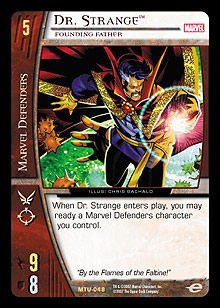 Dr. Strange, Founding Father is the one of the newest incarnations of Dr. Strange. He appears in the new Marvel Team-Up set, and is also the smallest in terms of recruitment cost. The fact that a 5-drop is the smallest version of Strange in our game is indicative of how powerful the Sorcerer Supreme is, especially if you keep in mind that even Superman has a 3-drop! This card’s affiliation and version clearly place it around the time when Dr. Strange formed the Marvel Defenders in comic book lore (back in 1971). He sports an extremely powerful effect that represents not only the magnitude of his magical abilities, but also his leadership skills as the driving force of the Marvel Defenders team. His come-into-play effect means that Founding Father is arguably only as powerful as those around him, but as anyone who has had an opponent resolve a Teen Titans Go!, Cosmic Radiation, or Press the Attack will know, readying effects are extremely powerful in Vs. System. This also makes him a great combo enabler, which, to me, is also in flavor with a magic user who weaves together mystical energies to craft awe-inspiring spells. The flavor text, “By the Flames of the Faltine!”—as well as that on other Dr. Strange–related cards in the Marvel Team-Up set—is also a nice tip of the hat to the comic history. Stan Lee wrote these alliterative exclamations and incantations, which themselves later became the foundation of Dr. Strange storylines.
Dr. Strange, Founding Father is the one of the newest incarnations of Dr. Strange. He appears in the new Marvel Team-Up set, and is also the smallest in terms of recruitment cost. The fact that a 5-drop is the smallest version of Strange in our game is indicative of how powerful the Sorcerer Supreme is, especially if you keep in mind that even Superman has a 3-drop! This card’s affiliation and version clearly place it around the time when Dr. Strange formed the Marvel Defenders in comic book lore (back in 1971). He sports an extremely powerful effect that represents not only the magnitude of his magical abilities, but also his leadership skills as the driving force of the Marvel Defenders team. His come-into-play effect means that Founding Father is arguably only as powerful as those around him, but as anyone who has had an opponent resolve a Teen Titans Go!, Cosmic Radiation, or Press the Attack will know, readying effects are extremely powerful in Vs. System. This also makes him a great combo enabler, which, to me, is also in flavor with a magic user who weaves together mystical energies to craft awe-inspiring spells. The flavor text, “By the Flames of the Faltine!”—as well as that on other Dr. Strange–related cards in the Marvel Team-Up set—is also a nice tip of the hat to the comic history. Stan Lee wrote these alliterative exclamations and incantations, which themselves later became the foundation of Dr. Strange storylines.
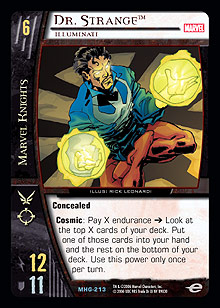 Dr. Strange, Illuminati is a 6-drop Marvel Knights character who appeared in the Heralds of Galactus expansion. In Marvel comics, it has recently been revealed that a group known as the Illuminati, which first appeared in New Avengers #7 (published July 2005), was formed shortly after the Kree-Skrull War (which featured in Marvel comics during the early 1970s). The Illuminati is a secret alliance of several prominent super heroes including Mr. Fantastic, Illuminati; Iron Man, Illuminati; Sub-Mariner, Illuminati; Black Bolt, Illuminati; and Professor X, Illuminati. According to creator Brian Michael Bendis, the group’s members “each represent a certain something that is very special to the Marvel universe.” The group shares important information and works behind the scenes for a perceived benefit. In this card, we see magic represented in a way similar to the Shadowpact characters and plot twists mentioned above. It also represents the extra information gained through Dr. Strange’s scrying abilities (and generally the psychic powers at his disposal) in the form of selective card draw. Being concealed also represents Dr. Strange’s ability to aid his colleagues from the wings, rather than just in physical conflict.
Dr. Strange, Illuminati is a 6-drop Marvel Knights character who appeared in the Heralds of Galactus expansion. In Marvel comics, it has recently been revealed that a group known as the Illuminati, which first appeared in New Avengers #7 (published July 2005), was formed shortly after the Kree-Skrull War (which featured in Marvel comics during the early 1970s). The Illuminati is a secret alliance of several prominent super heroes including Mr. Fantastic, Illuminati; Iron Man, Illuminati; Sub-Mariner, Illuminati; Black Bolt, Illuminati; and Professor X, Illuminati. According to creator Brian Michael Bendis, the group’s members “each represent a certain something that is very special to the Marvel universe.” The group shares important information and works behind the scenes for a perceived benefit. In this card, we see magic represented in a way similar to the Shadowpact characters and plot twists mentioned above. It also represents the extra information gained through Dr. Strange’s scrying abilities (and generally the psychic powers at his disposal) in the form of selective card draw. Being concealed also represents Dr. Strange’s ability to aid his colleagues from the wings, rather than just in physical conflict.
 Dr. Strange, Stephen Strange, a 7-drop for the Marvel Knights team, was the first incarnation of the character we saw in Vs. System. When Stephen Strange first hit the scene, his text box—and specifically his boost effect—more or less read, “Win the game.” Essentially brushing all of his opponents aside by banishing them to some dark dimension with his teleportation powers, Dr. Strange’s colleagues were left free to either attack your opponent directly or isolate any weak links. While it might not be as game-winning today, it’s still a big effect and a great representation of Dr. Strange’s ability to have a massive impact in any conflict.
Dr. Strange, Stephen Strange, a 7-drop for the Marvel Knights team, was the first incarnation of the character we saw in Vs. System. When Stephen Strange first hit the scene, his text box—and specifically his boost effect—more or less read, “Win the game.” Essentially brushing all of his opponents aside by banishing them to some dark dimension with his teleportation powers, Dr. Strange’s colleagues were left free to either attack your opponent directly or isolate any weak links. While it might not be as game-winning today, it’s still a big effect and a great representation of Dr. Strange’s ability to have a massive impact in any conflict.
Dr. Strange, Sorcerer Supreme, as his version suggests, is the ultimate version of the character in Vs. System. He is also the biggest character on the Marvel Defenders roster. While I’d personally love for his stats to be on or above average for an 8-drop, there is no denying the power of his come-into-play effect. More or less a souped up version of Founding Father, the Sorcerer Supreme is a Cosmic Radiation on legs. Considering that Dr. Strange can generate energy bolts that could potentially destroy planets, it’s fitting that he appears as an 8-drop character card.
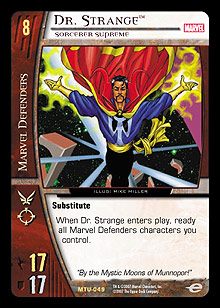 While distilling the awesome power and almost limitless list of abilities the Sorcerer Supreme has at his disposal into Vs. System character cards would prove a challenge for anyone, I think UDE has struck a nice balance with Dr. Strange. But I would be interested to hear (via the below email address) from some committed Dr. Strange fans out there to get a purist’s point of view.
While distilling the awesome power and almost limitless list of abilities the Sorcerer Supreme has at his disposal into Vs. System character cards would prove a challenge for anyone, I think UDE has struck a nice balance with Dr. Strange. But I would be interested to hear (via the below email address) from some committed Dr. Strange fans out there to get a purist’s point of view.
Regular readers might remember from the first Living Ink that this series is largely inspired by a column series published at www.vsparadise.com. On the Face of Things was expertly written by James Paraha, but unfortunately, family and work commitments meant the series was short lived. That said, one of the articles James wrote focused on Dr. Strange. The article is a little dated because it was written about eighteen months ago, but it still probably puts my trivial scribblings to shame. Check out James’s Dr. Strange article here.
Finally, I owe you guys a quick reading list:
· Strange #1-6 (2004 - 2005) – Retelling of Dr. Strange’s origin (republished in the Strange: Beginning and Endings TPB).
· Doctor Strange: The Oath #1-5 (2006 - 2007)
· Doctor Strange (Vol. 2) #1-4 (1999) – “The Flight of Bones,” published under the Marvel Knights imprint.
· The New Avengers UPCOMING ISSUES – Dr. Strange will join the team in upcoming issues (following the conclusion of Civil War).
· Essential Doctor Strange Volume 1 TPB – 608 pages (black and white) collecting Strange Tales #110-111 and #114-168.
See you in the funny pages,
Michael Pittman
ikeebear@hotmail.com